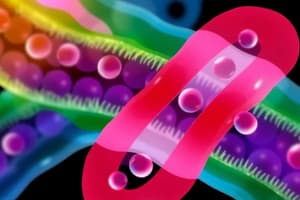Podcast
Questions and Answers
What primarily contributes to the insolubility of lipids in water?
What primarily contributes to the insolubility of lipids in water?
- A reduced proportion of oxygen to carbon and hydrogen (correct)
- The presence of polar bonds in the structure
- The high molecular weight of lipid molecules
- The high proportion of -OH groups
Which of the following is NOT a type of lipid mentioned?
Which of the following is NOT a type of lipid mentioned?
- Steroids
- Phospholipids
- Nucleotides (correct)
- Triglycerides
How is a triglyceride molecule formed?
How is a triglyceride molecule formed?
- By combining two fatty acids with one glycerol
- By combining four fatty acids with two glycerols
- By combining three fatty acids with one glycerol (correct)
- By combining one fatty acid with one glycerol
Why do fats float on water?
Why do fats float on water?
What is a common characteristic of the tails of triglycerides?
What is a common characteristic of the tails of triglycerides?
What is the primary reason for lipids' insolubility in water?
What is the primary reason for lipids' insolubility in water?
Which statement about triglycerides is accurate?
Which statement about triglycerides is accurate?
What role does the structure of fatty acids play in the characteristics of triglycerides?
What role does the structure of fatty acids play in the characteristics of triglycerides?
What is formed as a result of the reaction between fatty acids and an alcohol?
What is formed as a result of the reaction between fatty acids and an alcohol?
Which of the following statements about the components of lipids is true?
Which of the following statements about the components of lipids is true?
What is the main reason lipids are classified as hydrophobic?
What is the main reason lipids are classified as hydrophobic?
Which of the following compounds is formed from fatty acids and glycerol?
Which of the following compounds is formed from fatty acids and glycerol?
What distinguishes different triglycerides from each other?
What distinguishes different triglycerides from each other?
What defines a phospholipid's structure compared to triglycerides?
What defines a phospholipid's structure compared to triglycerides?
Which statement about the density of fats is correct?
Which statement about the density of fats is correct?
Flashcards are hidden until you start studying
Study Notes
Lipids Overview
- Organic molecules that are insoluble in water, primarily due to their non-polar nature.
- Composed of carbon, hydrogen, and oxygen, but with a lower proportion of oxygen compared to carbohydrates.
- A reduced number of polar -OH (hydroxyl) groups contributes to their hydrophobic characteristics.
Solubility and Density
- Lipids cannot form hydrogen bonds with water, making them hydrophobic.
- They are less dense than water, allowing them to float.
Ester Formation
- Esters are formed when fatty acids combine with alcohol.
- Key lipids include triglycerides, phospholipids, and steroids.
Triglycerides
- Comprised of three fatty acid tails linked to one glycerol through three ester bonds.
- Varieties of triglycerides exist due to differences in the length and structure of fatty acid tails.
Glyceride Formation
- Glycerides are specific esters created from the combination of fatty acids and glycerol.
Lipids Overview
- Organic molecules that are insoluble in water, primarily due to their non-polar nature.
- Composed of carbon, hydrogen, and oxygen, but with a lower proportion of oxygen compared to carbohydrates.
- A reduced number of polar -OH (hydroxyl) groups contributes to their hydrophobic characteristics.
Solubility and Density
- Lipids cannot form hydrogen bonds with water, making them hydrophobic.
- They are less dense than water, allowing them to float.
Ester Formation
- Esters are formed when fatty acids combine with alcohol.
- Key lipids include triglycerides, phospholipids, and steroids.
Triglycerides
- Comprised of three fatty acid tails linked to one glycerol through three ester bonds.
- Varieties of triglycerides exist due to differences in the length and structure of fatty acid tails.
Glyceride Formation
- Glycerides are specific esters created from the combination of fatty acids and glycerol.
Lipids Overview
- Organic molecules that are insoluble in water, primarily due to their non-polar nature.
- Composed of carbon, hydrogen, and oxygen, but with a lower proportion of oxygen compared to carbohydrates.
- A reduced number of polar -OH (hydroxyl) groups contributes to their hydrophobic characteristics.
Solubility and Density
- Lipids cannot form hydrogen bonds with water, making them hydrophobic.
- They are less dense than water, allowing them to float.
Ester Formation
- Esters are formed when fatty acids combine with alcohol.
- Key lipids include triglycerides, phospholipids, and steroids.
Triglycerides
- Comprised of three fatty acid tails linked to one glycerol through three ester bonds.
- Varieties of triglycerides exist due to differences in the length and structure of fatty acid tails.
Glyceride Formation
- Glycerides are specific esters created from the combination of fatty acids and glycerol.
Studying That Suits You
Use AI to generate personalized quizzes and flashcards to suit your learning preferences.




